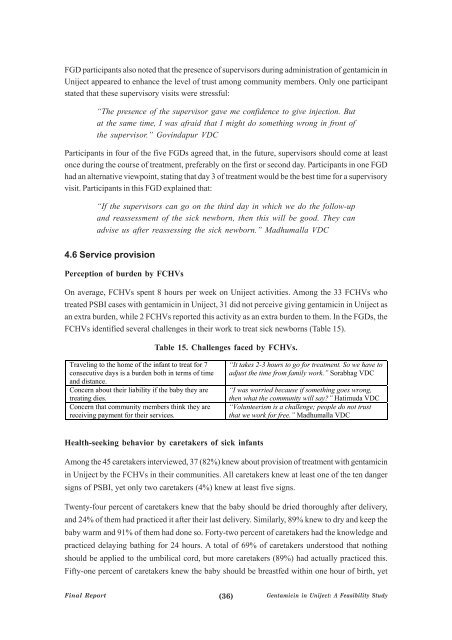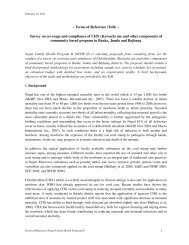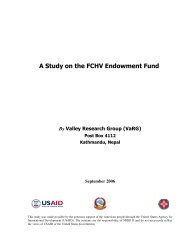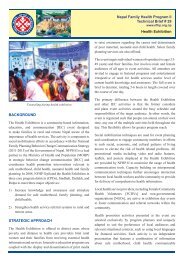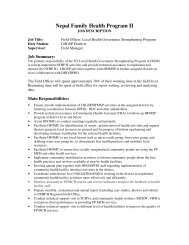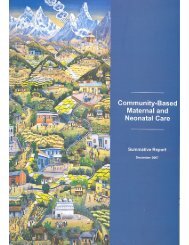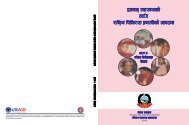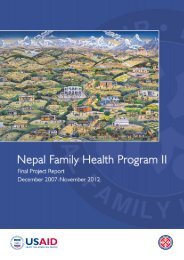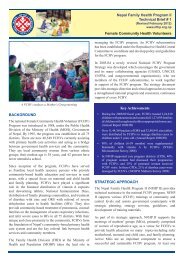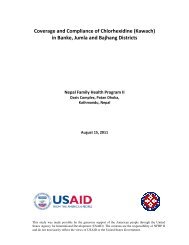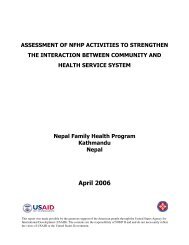Design-Stage Trial of Gentamicin in the Uniject Device
Design-Stage Trial of Gentamicin in the Uniject Device
Design-Stage Trial of Gentamicin in the Uniject Device
Create successful ePaper yourself
Turn your PDF publications into a flip-book with our unique Google optimized e-Paper software.
FGD participants also noted that <strong>the</strong> presence <strong>of</strong> supervisors dur<strong>in</strong>g adm<strong>in</strong>istration <strong>of</strong> gentamic<strong>in</strong> <strong>in</strong><strong>Uniject</strong> appeared to enhance <strong>the</strong> level <strong>of</strong> trust among community members. Only one participantstated that <strong>the</strong>se supervisory visits were stressful:“The presence <strong>of</strong> <strong>the</strong> supervisor gave me confidence to give <strong>in</strong>jection. Butat <strong>the</strong> same time, I was afraid that I might do someth<strong>in</strong>g wrong <strong>in</strong> front <strong>of</strong><strong>the</strong> supervisor.” Gov<strong>in</strong>dapur VDCParticipants <strong>in</strong> four <strong>of</strong> <strong>the</strong> five FGDs agreed that, <strong>in</strong> <strong>the</strong> future, supervisors should come at leastonce dur<strong>in</strong>g <strong>the</strong> course <strong>of</strong> treatment, preferably on <strong>the</strong> first or second day. Participants <strong>in</strong> one FGDhad an alternative viewpo<strong>in</strong>t, stat<strong>in</strong>g that day 3 <strong>of</strong> treatment would be <strong>the</strong> best time for a supervisoryvisit. Participants <strong>in</strong> this FGD expla<strong>in</strong>ed that:“If <strong>the</strong> supervisors can go on <strong>the</strong> third day <strong>in</strong> which we do <strong>the</strong> follow-upand reassessment <strong>of</strong> <strong>the</strong> sick newborn, <strong>the</strong>n this will be good. They canadvise us after reassess<strong>in</strong>g <strong>the</strong> sick newborn.” Madhumalla VDC4.6 Service provisionPerception <strong>of</strong> burden by FCHVsOn average, FCHVs spent 8 hours per week on <strong>Uniject</strong> activities. Among <strong>the</strong> 33 FCHVs whotreated PSBI cases with gentamic<strong>in</strong> <strong>in</strong> <strong>Uniject</strong>, 31 did not perceive giv<strong>in</strong>g gentamic<strong>in</strong> <strong>in</strong> <strong>Uniject</strong> asan extra burden, while 2 FCHVs reported this activity as an extra burden to <strong>the</strong>m. In <strong>the</strong> FGDs, <strong>the</strong>FCHVs identified several challenges <strong>in</strong> <strong>the</strong>ir work to treat sick newborns (Table 15).Table 15. Challenges faced by FCHVs.Travel<strong>in</strong>g to <strong>the</strong> home <strong>of</strong> <strong>the</strong> <strong>in</strong>fant to treat for 7consecutive days is a burden both <strong>in</strong> terms <strong>of</strong> timeand distance.Concern about <strong>the</strong>ir liability if <strong>the</strong> baby <strong>the</strong>y aretreat<strong>in</strong>g dies.Concern that community members th<strong>in</strong>k <strong>the</strong>y arereceiv<strong>in</strong>g payment for <strong>the</strong>ir services.“It takes 2-3 hours to go for treatment. So we have toadjust <strong>the</strong> time from family work.” Sorabhag VDC“I was worried because if someth<strong>in</strong>g goes wrong,<strong>the</strong>n what <strong>the</strong> community will say?” Hatimuda VDC“Volunteerism is a challenge; people do not trustthat we work for free.” Madhumalla VDCHealth-seek<strong>in</strong>g behavior by caretakers <strong>of</strong> sick <strong>in</strong>fantsAmong <strong>the</strong> 45 caretakers <strong>in</strong>terviewed, 37 (82%) knew about provision <strong>of</strong> treatment with gentamic<strong>in</strong><strong>in</strong> <strong>Uniject</strong> by <strong>the</strong> FCHVs <strong>in</strong> <strong>the</strong>ir communities. All caretakers knew at least one <strong>of</strong> <strong>the</strong> ten dangersigns <strong>of</strong> PSBI, yet only two caretakers (4%) knew at least five signs.Twenty-four percent <strong>of</strong> caretakers knew that <strong>the</strong> baby should be dried thoroughly after delivery,and 24% <strong>of</strong> <strong>the</strong>m had practiced it after <strong>the</strong>ir last delivery. Similarly, 89% knew to dry and keep <strong>the</strong>baby warm and 91% <strong>of</strong> <strong>the</strong>m had done so. Forty-two percent <strong>of</strong> caretakers had <strong>the</strong> knowledge andpracticed delay<strong>in</strong>g bath<strong>in</strong>g for 24 hours. A total <strong>of</strong> 69% <strong>of</strong> caretakers understood that noth<strong>in</strong>gshould be applied to <strong>the</strong> umbilical cord, but more caretakers (89%) had actually practiced this.Fifty-one percent <strong>of</strong> caretakers knew <strong>the</strong> baby should be breastfed with<strong>in</strong> one hour <strong>of</strong> birth, yetF<strong>in</strong>al Report(36) <strong>Gentamic<strong>in</strong></strong> <strong>in</strong> <strong>Uniject</strong>: A Feasibility Study


